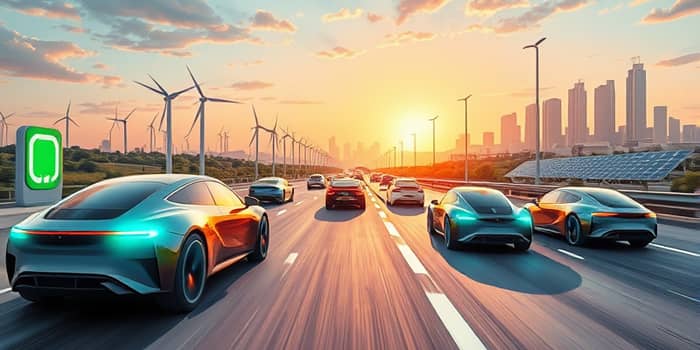
The automotive industry is undergoing a profound transformation, driven by the relentless rise of electric vehicles (EVs). Once niche curiosities, EVs now account for a significant share of global vehicle sales, upending traditional market dynamics and creating fresh opportunities—and risks—for investors worldwide.
From surging sales figures to policy incentives and groundbreaking technology, every facet of the sector is shifting. Investors who understand these trends can position their portfolios to capture the next wave of growth.
In Q1 2025, over 4 million EVs were sold worldwide, representing a stunning 35% increase from the same period in 2024. Total global electric car sales topped 17 million units in 2024, accounting for more than 20% of all new cars sold—a threefold increase compared to just four years prior.
Yet growth is uneven across regions. China dominates, with nearly half of all new cars sold in 2024 being electric and two-thirds of global EV manufacturing capacity. Meanwhile, the United States achieved 300,000 new EV sales in Q1 2025—7.5% of total new-vehicle sales—up from 7% a year earlier. Europe continues to push hard, while several emerging markets are accelerating adoption through cost-effective models.
Legacy automakers are scrambling to keep pace. General Motors sold over 30,000 EVs in Q1 2025—nearly doubling its volume from the previous year—while Ford and Stellantis ramped up deliveries across their electric lineups. Yet many traditional players still lag behind nimble competitors.
Chinese giants BYD, Nio, Xpeng, and Li Auto loom large on the global stage. BYD has become a powerhouse, delivering millions of units annually, while Nio and Xpeng push cutting-edge digital interfaces despite narrow profit margins. In North America, startups like Lucid and Rivian have begun scaled deliveries—Lucid with its luxurious Air sedan and Rivian with the R1T pickup and R1S SUV.
China’s approach to EVs emphasizes the fusion of hardware and software, creating what many analysts dub computers with batteries on wheels. Advanced driver-assist systems, generative AI dashboards, and connected services are now core differentiators.
This software-centric strategy has ripple effects globally. European and American automakers are forging partnerships with tech firms, while battery makers race to develop solid-state cells that promise faster charging and greater energy density. Investors eye companies like QuantumScape, Romeo Power, and CATL for their potential breakthroughs.
Government initiatives play a central role in accelerating EV adoption. Decarbonization goals tied to net-zero commitments for 2050 have prompted generous subsidies, tax credits, and infrastructure spending in Europe and China. The U.S. Inflation Reduction Act offers federal credits for consumers and manufacturers, though future political shifts could reshape these incentives.
Regulatory landscapes vary widely, with some markets phasing out internal combustion engines entirely by 2035, while others leave adoption largely to consumer choice. Staying abreast of policy developments is crucial for investors seeking to anticipate market accelerations or slowdowns.
Batteries remain the linchpin of EV economics. Innovations in solid-state chemistry promise leapfrog improvements in cost and performance. Companies like QuantumScape and Solid Power are in the spotlight, while established firms such as Panasonic and LG Energy Solution continually refine lithium-ion technology.
Meanwhile, charging infrastructure is expanding rapidly. Public networks operated by ChargePoint, EVgo, Blink Charging, and Wallbox are scaling installations, while automakers invest in proprietary fast-charging corridors. Seamless charging experiences are vital to alleviate range anxiety and unlock broader consumer adoption.
Despite robust headline figures, obstacles remain. EV adoption in the U.S. plateaued around 7% in mid-2025, lagging behind Europe and China. Supply chain constraints—particularly in lithium, nickel, and cobalt—could pressure battery costs.
Automakers face tough decisions: adjust production targets, manage inventory, and navigate evolving consumer preferences. Profitability challenges persist for many startups, and legacy manufacturers must balance EV investments against cash flows from their combustible- engine businesses.
Electrification is no longer confined to sedans and SUVs. Buses, delivery trucks, and two- and three-wheelers are undergoing rapid electrification, especially in emerging economies. Hybrid powertrains and range extenders serve as bridging technologies in regions with limited charging networks.
For investors, this broadening ecosystem offers diverse entry points—from battery metals and charging networks to fleet electrification services and autonomous driving platforms. Smart portfolio diversification can capture gains across the entire value chain.
As the automotive industry accelerates towards an all-electric future, stocks will continue to shift gears. Companies that blend technological prowess with strategic foresight will lead the charge, while those slow to adapt risk being left in the dust. By understanding the market’s key drivers—sales trends, policy incentives, and innovation hotspots—investors can navigate volatility and seize the long-term growth opportunities presented by the EV revolution.
References













